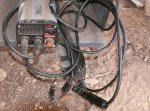ckirklen
New member
This was the hardest answer to find: what size generator do I need to run a stick welder when I have a remote project like a fence repair?
I saw lots of anecdotal data like “you’ll need at least 10kW to run a stick welder”, yet the Hobart Champion 145 welder/generator Only provides 4000 watts continuous.Even the Lincoln Electric site states at least 10kW are required. Then there’s Watts required = volts * amps, which leads me to believe I’d need only 120 * 220 = 2640 watts, which sounds like a wimpy generator. Very confusing to a non-EE.
So found a deal at Costco on a Firman gen (assembled in AZ) with 7500W continuous and 9500 surge for a great price and the welds I did on a fence with my cracker box stick welder - even at 120 amps on 110v - were easily as pretty as the ones made with the Bobcat 250 I had rented before buying the genny.
i was welding cleats on 1/8” metal posts using 1/8” E6013 rods at 120A on 110v (only because I didn’t have the right plug for 220v off that generator).
So my contribution is that in the case of a dual-voltage cracker box stick welder at 120A, if you have a generator that puts out 7500W continuous, you’re gtg! Maybe you can get by on less, but not seeing the need for 10kW for farm use.
My goal was to not have to buy TOO big a genny ($$$) but enough to get the job done. Hope that’s useful to the next “me” asking this question.
I saw lots of anecdotal data like “you’ll need at least 10kW to run a stick welder”, yet the Hobart Champion 145 welder/generator Only provides 4000 watts continuous.Even the Lincoln Electric site states at least 10kW are required. Then there’s Watts required = volts * amps, which leads me to believe I’d need only 120 * 220 = 2640 watts, which sounds like a wimpy generator. Very confusing to a non-EE.
So found a deal at Costco on a Firman gen (assembled in AZ) with 7500W continuous and 9500 surge for a great price and the welds I did on a fence with my cracker box stick welder - even at 120 amps on 110v - were easily as pretty as the ones made with the Bobcat 250 I had rented before buying the genny.
i was welding cleats on 1/8” metal posts using 1/8” E6013 rods at 120A on 110v (only because I didn’t have the right plug for 220v off that generator).
So my contribution is that in the case of a dual-voltage cracker box stick welder at 120A, if you have a generator that puts out 7500W continuous, you’re gtg! Maybe you can get by on less, but not seeing the need for 10kW for farm use.
My goal was to not have to buy TOO big a genny ($$$) but enough to get the job done. Hope that’s useful to the next “me” asking this question.

